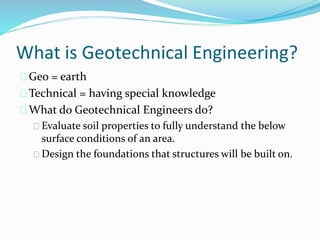Facts About Geotheta Uncovered
Table of ContentsOur Geotheta IdeasFacts About Geotheta UncoveredThe Geotheta Ideas3 Easy Facts About Geotheta ExplainedSome Known Incorrect Statements About Geotheta

They carry out website examinations, accumulate samples, execute laboratory tests, and assess information to evaluate the suitability of the ground for building projects - Consulting Engineer. Based on their findings, geotechnical engineers supply referrals for foundation style, slope stability, retaining frameworks, and reduction of geotechnical hazards. They collaborate with other experts, such as engineers, architectural designers, and construction groups, to make sure that geotechnical considerations are integrated right into the overall project style and execution
By evaluating the behavior and residential properties of dirt and rock, they can identify potential geotechnical hazards such as landslides, soil negotiation, or incline instability. Their expertise aids stop failings or mishaps that could threaten lives and home. Here are some detailed obligations and duties of a geotechnical designer: Site Investigation: Geotechnical engineers conduct website examinations to gather information on subsurface conditions.
They analyze the information to recognize the homes and behavior of the soil and rock, including their strength, leaks in the structure, compaction characteristics, and groundwater conditions. Geotechnical Evaluation and Style: Geotechnical engineers evaluate the information collected throughout website examinations to evaluate the stability and viability of the website for building and construction tasks. They carry out geotechnical estimations and modeling to assess factors such as bearing capability, negotiation, slope stability, lateral earth stress, and groundwater flow.
The Only Guide for Geotheta
Structure Style: Geotechnical engineers play a crucial role in creating foundations that can securely sustain the desired structure. They assess the dirt problems and lots demands to establish the proper structure kind, such as shallow foundations (e.g., footings), deep structures (e.g (https://allmyfaves.com/geotheta?tab=Geotheta)., heaps), or specialized techniques like soil enhancement. They consider elements such as settlement restrictions, bearing capacity, and soil-structure interaction to establish ideal structure styles
They evaluate construction strategies, monitor website activities, and carry out area examinations to verify that the layout recommendations are complied with. If unpredicted geotechnical issues develop, they assess the situation and provide referrals for removal or adjustments to the style. Danger Assessment and Reduction: Geotechnical engineers evaluate geotechnical hazards and dangers connected with the job website, such as landslides, liquefaction, or soil disintegration.

Partnership and Communication: Geotechnical designers function closely with various other experts associated with a project, such as engineers, architectural designers, and building teams. Reliable communication and collaboration are important to incorporate geotechnical considerations into the general task style and building process. Geotechnical designers supply technological experience, response questions, and make certain that geotechnical demands are met.
5 Simple Techniques For Geotheta
Below are some kinds of geotechnical designers: Structure Engineer: Structure designers specialize in creating and analyzing foundations for structures. They evaluate the dirt problems, load requirements, and website characteristics to determine one of the most appropriate foundation type and style, such as superficial foundations, deep foundations, or specialized strategies like stack foundations.
They evaluate the factors influencing incline security, such as soil properties, groundwater problems, and incline geometry, and establish strategies to avoid slope failings and minimize risks. Quake Engineer: Quake engineers concentrate on assessing and making structures to endure seismic forces. They examine the seismic danger of a website, examine soil liquefaction potential, and establish seismic design standards to make certain the safety and security and strength of structures during earthquakes.
They perform field testing, collect examples, and assess the collected information to identify the dirt buildings, geologic formations, and groundwater conditions at a website. Geotechnical Instrumentation Designer: Geotechnical instrumentation engineers concentrate on surveillance and determining the habits of soil, rock, and structures. They install and keep instrumentation systems that monitor factors such as dirt settlement, groundwater degrees, incline motions, and structural variations to analyze performance and provide very early warnings of potential concerns.
Geotheta for Dummies
They conduct examinations such as triaxial tests, combination examinations, direct shear examinations, and permeability examinations to gather data for geotechnical evaluation and layout. Geosynthetics Designer: Geosynthetics engineers specialize in the layout and application of geosynthetic materials, such as geotextiles, geogrids, and geomembranes. They use these products to boost soil security, reinforce inclines, provide drain services, and control disintegration.
They often tend to be investigative people, which suggests they're intellectual, introspective, and analytical. They are curious, methodical, reasonable, logical, and rational. Some of them are additionally social, implying they're kind, generous, cooperative, client, caring, practical, understanding, sensible, and friendly - Engineer of Record.
In the office environment, geotechnical engineers make use of specialized software pop over to this web-site tools to perform calculations, create layouts, and analyze information. They prepare reports, evaluation project requirements, communicate with customers and staff member, and coordinate project activities. The office setting offers a conducive setting for research study, analysis, and collaboration with other experts associated with the task.
The smart Trick of Geotheta That Nobody is Discussing
They regularly go to task sites to perform website investigations, assess geotechnical conditions, and gather information for analysis. These check outs involve traveling to various areas, in some cases in remote or challenging surfaces. Geotechnical engineers might do soil tasting, conduct examinations, and display building activities to make sure that the geotechnical aspects of the job are being executed appropriately.
Geotechnical designers also work in specialized geotechnical research laboratories. Geotechnical research laboratory designers work thoroughly in these environments, dealing with testing tools, operating instruments, and videotaping data.